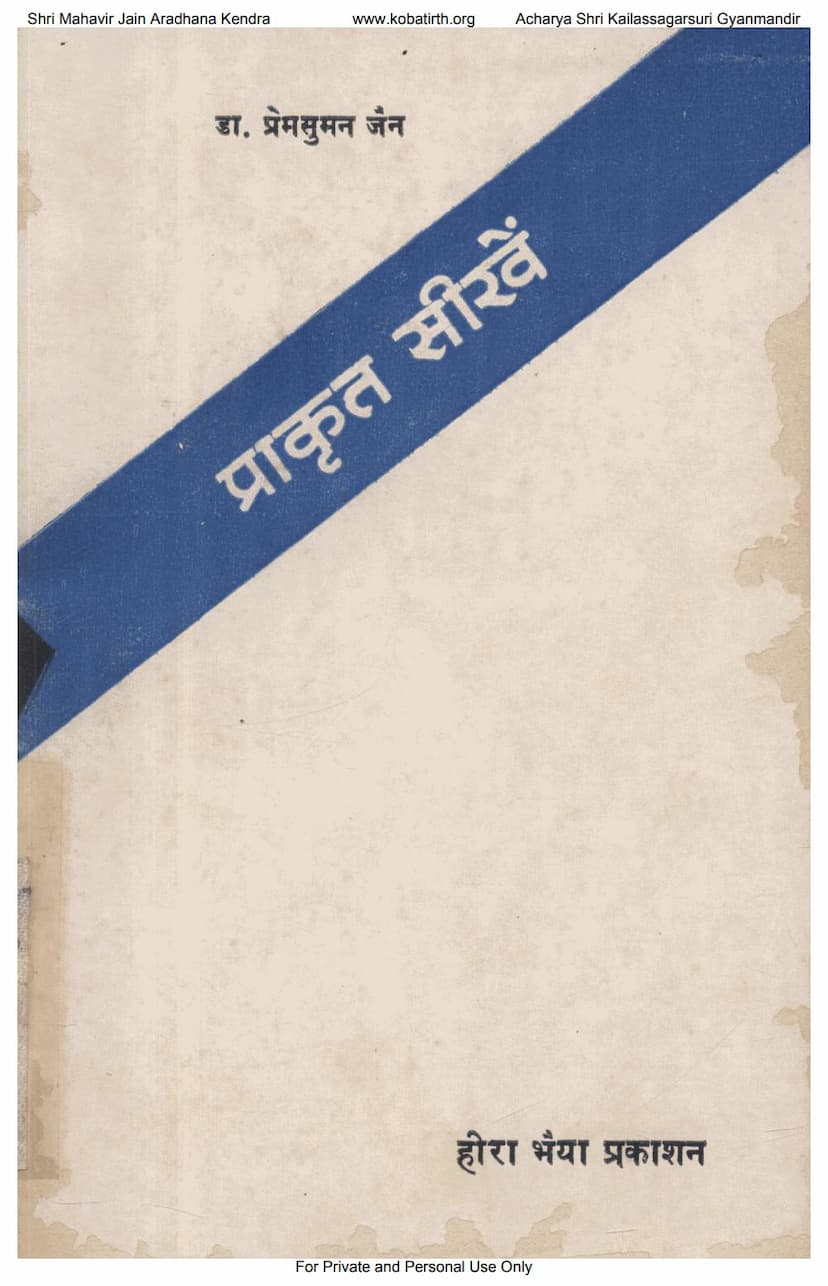Prakrit Sikhe
Added to library: September 2, 2025

Summary
Here's a comprehensive summary of the Jain text "Prakrit Sikhe" by Premsuman Jain, based on the provided pages:
Book Title: Prakrit Sikhe (Learn Prakrit) Author: Dr. Premsuman Jain Publisher: Hirabhaiya Prakashan Year of Publication: 1979
Overview:
"Prakrit Sikhe" is a foundational grammar book designed to teach the Prakrit language, particularly with a focus on its relevance to Jain literature and philosophy. The book aims to make learning Prakrit accessible and engaging for a general audience, bridging the gap between ancient Jain texts and modern readers. It emphasizes the historical development of Prakrit, its relationship with Sanskrit, and its crucial role in transmitting Jain teachings.
Key Themes and Content:
-
Introduction to Prakrit Language and Literature (Path 1):
- Ancient Roots: The text traces Prakrit's origins back to the vernacular dialects of ancient India, existing alongside Vedic and later Sanskrit. It highlights the influence of regional dialects (Udiichya, Madhyadeshiya, Prachya) on the development of both Sanskrit and Prakrit.
- Jain Connection: It emphasizes that Buddha and Mahavir chose the vernacular languages (which evolved into Pali and Prakrit) for their teachings, making them accessible to the common people. Prakrit is presented as a sister language to Sanskrit, equally ancient, but with distinct literary traditions.
- Relationship with Sanskrit: The book details the linguistic and literary connections between Prakrit and Sanskrit, noting similarities derived from their common ancestor (the spoken language). It categorizes Prakrit words into Tatsama (identical to Sanskrit), Tadbhava (evolved from Sanskrit), and Deshya (indigenous).
- Meaning of "Prakrit": The author addresses the misconception that Prakrit is merely a "corrupted" form of Sanskrit. It explains that "Prakrit" signifies the natural, unadorned language of ordinary people, derived from "prakriti" (nature). The Jain Agamas, being the first works composed in these vernaculars, are thus considered "Prakrit."
- Classification of Prakrit: The text categorizes Prakrit literature into different periods (Early, Middle, Apabhramsha) and outlines key Prakrit dialects like Ardhamagadhi, Shauraseni, Maharashtri, Magadhi, and Paishachi, briefly describing their characteristics and usage, especially in Jain texts.
- Influence on Modern Languages: A significant portion highlights Prakrit's foundational role in the development of modern Indian languages, demonstrating this through numerous word examples across Gujarati, Rajasthani, Odia, Maithili, Bhojpuri, Bundelkhandi, Marathi, Kannada, Tamil, and Telugu.
-
Phonological Features (Path 2):
- Sound Changes: This chapter delves into the characteristic sound changes from Sanskrit to Prakrit. It meticulously explains vowel changes (lengthening of short vowels, shortening of long vowels, vowel elision, diphthong simplifications) and consonant changes (nasalization, assimilation, elision, substitution).
- Grammar Resources: The author acknowledges existing Prakrit grammars (like those by Hemachandra and Vararuchi) but notes the lack of a simple, accessible textbook for modern learners. Several scholarly works are cited as references.
- Purpose of the Book: The book aims to provide a concise and easy-to-understand introduction to Prakrit, enabling readers to appreciate ancient literature and Jain philosophy. Examples and practice sentences are drawn from Agam literature.
-
Noun Forms and Usage (Paths 3, 4, 5, 6):
- Gender and Number: The text systematically explains the declension of nouns in Prakrit, covering masculine (ending in -a, -i, -u), feminine (ending in -ā, -i, -u, -ū), and neuter genders. It clarifies that the dual number is largely replaced by the plural.
- Case Endings: Detailed tables and examples illustrate the various case endings (Prathama, Dvitiya, Tritiya, Chaturthi, Panchami, Shashti, Saptami, Sambodhana) for different noun types.
- Pronoun Usage: A dedicated chapter explains the use of pronouns (demonstrative, interrogative, relative, personal), providing their forms and example sentences to demonstrate their function in replacing nouns.
- Verb Conjugation (Present Tense): The book introduces the basic conjugation of verbs in the present tense, outlining the personal endings for different persons and numbers.
- Past and Future Tenses: Chapters 8 and 9 detail the formation and usage of past and future tense verbs, highlighting the relative simplicity of Prakrit verb conjugation compared to Sanskrit.
- Imperative and Potential Moods (Path 10): The text explains the formation and use of imperative (command/request) and potential/subjunctive moods, often used for advice, eligibility, and expressing desires.
- Kridanta Forms (Path 11): This chapter covers participial forms (present, past, future, causal, conditional) and their role in forming complex sentences, simplifying sentence structure and adding nuance.
- Passive Voice and Impersonal Constructions (Path 10 & 11): The book touches upon the formation of passive and impersonal verb forms, explaining how they are used to indicate actions without specifying the doer.
-
Syntax and Word Formation (Path 12):
- Sandhi (Vowel and Consonant Assimilation): The book explains the rules of sandhi (joining of sounds), noting that its application in Prakrit is often optional and influenced by the spoken language.
- Samasa (Compound Words): It discusses the use of compound words (Avyayibhav, Tatpurush, Karmadharaya, Dviguh, Dvanda, Bahuvrihi) in Prakrit, noting that the emphasis is on the meaning and usage rather than strict grammatical rules.
- Taddhita (Derivational Suffixes): The text introduces various suffixes used to form new words from existing roots, enriching the Prakrit vocabulary.
- Adverbs and Adjectives: Common adverbs and adjectives are presented with their usage and agreement rules.
-
Appendices:
- Prakrit Alphabet: A listing of Prakrit vowels and consonants.
- Common Sound Changes: Detailed lists of typical sound transformations from Sanskrit to Prakrit, covering vowels and consonants. This section provides valuable insights into the phonetic evolution of the language.
Overall Purpose and Impact:
"Prakrit Sikhe" is designed to be a practical guide for learning Prakrit, making it accessible to Jain students and anyone interested in understanding the language of classical Jain texts. By breaking down grammar, providing numerous examples, and offering exercises, the book aims to equip readers with the foundational knowledge needed to engage with Jain scriptures and literature. It serves as a vital resource for preserving and promoting the study of Prakrit within the Jain tradition and beyond.